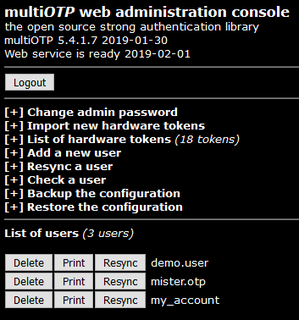OPIE is the initialism of "One time Passwords In Everything". Opie is a mature, Unix-like login and password package installed on the server and the client which makes untrusted networks safer against password-sniffing packet-analysis software like dSniff and safe against Shoulder surfing. It works by circumventing the delayed attack method because the same password is never used twice after installing Opie. OPIE implements a one-time password (OTP) scheme based on S/KEY, which will require a secret passphrase (not echoed) to generate a password for the current session, or a list of passwords you can print and carry on your person.
The Capability Maturity Model (CMM) is a development model created after a study of data collected from organizations that contracted with the U.S. Department of Defense, who funded the research. The term "maturity" relates to the degree of formality and optimization of processes, from ad hoc practices, to formally defined steps, to managed result metrics, to active optimization of the processes.

A Unix-like operating system is one that behaves in a manner similar to a Unix system, while not necessarily conforming to or being certified to any version of the Single UNIX Specification. A Unix-like application is one that behaves like the corresponding Unix command or shell. There is no standard for defining the term, and some difference of opinion is possible as to the degree to which a given operating system or application is "Unix-like".

A password is a word or string of characters used for user authentication to prove identity or access approval to gain access to a resource, which is to be kept secret from those not allowed access.
OPIE uses an MD4 or MD5 hash function to generate passwords.

A hash function is any function that can be used to map data of arbitrary size onto data of a fixed size. The values returned by a hash function are called hash values, hash codes, digests, or simply hashes. Hash functions are often used in combination with a hash table, a common data structure used in computer software for rapid data lookup. Hash functions accelerate table or database lookup by detecting duplicated records in a large file. One such application is finding similar stretches in DNA sequences. They are also useful in cryptography. A cryptographic hash function allows one to easily verify whether some input data map onto a given hash value, but if the input data is unknown it is deliberately difficult to reconstruct it by knowing the stored hash value. This is used for assuring integrity of transmitted data, and is the building block for HMACs, which provide message authentication.
OPIE can restrict its logins based on IP address. It uses its own passwd and login modules.
If the Enter key ↵ Enter is pressed at the password prompt, it will turn echo on, so what is being typed can be seen when entering an unfamiliar password from a printout.

On computer keyboards, the enter key in most cases causes a command line, window form, or dialog box to operate its default function. This is typically to finish an "entry" and begin the desired process, and is usually an alternative to pressing an OK button.
OPIE will improve security when accessing online banking at conferences, hotels and airports. Some countries require banks to implement OTP.
OPIE shipped with DragonFly BSD, FreeBSD and OpenSUSE. It can be installed on a Unix-like server and clients for improved security.

DragonFly BSD is a free and open-source Unix-like operating system forked from FreeBSD 4.8. Matthew Dillon, an Amiga developer in the late 1980s and early 1990s and FreeBSD developer between 1994 and 2003, began working on DragonFly BSD in June 2003 and announced it on the FreeBSD mailing lists on 16 July 2003.

FreeBSD is a free and open-source Unix-like operating system descended from the Berkeley Software Distribution (BSD), which was based on Research Unix. The first version of FreeBSD was released in 1993. In 2005, FreeBSD was the most popular open-source BSD operating system, accounting for more than three-quarters of all installed BSD systems.

openSUSE, formerly SUSE Linux and SuSE Linux Professional, is a Linux distribution sponsored by SUSE Linux GmbH and other companies. It is widely used throughout the world. The focus of its development is creating usable open-source tools for software developers and system administrators, while providing a user-friendly desktop and feature-rich server environment.
The commands are
opiepasswdopiekey

